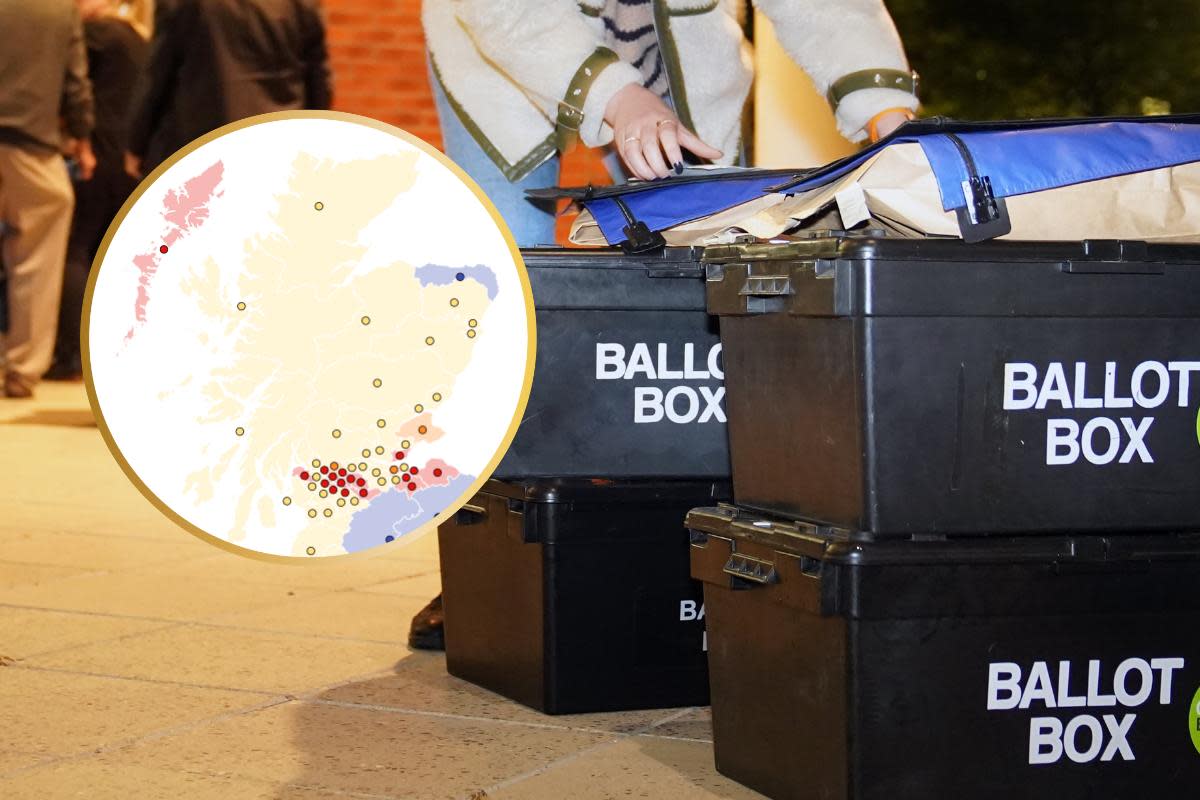New model predicts winner of all Scottish seats at General Election – see full list

THE result of every constituency in Scotland has been predicted by new modelling from a top magazine.
The Economist’s UK General Election tracker and probability model anticipates a major landslide for Labour.
Keir Starmer’s party are given an 87% chance of winning a majority in the House of Commons, with a 12% chance of being the largest party but in the minority.
The Tories are given a 1% chance of being the largest party but without a majority, and a less than 1% chance of winning a majority.
Over Great Britain’s 632 Westminster seats (excluding the 18 in Northern Ireland), The Economist predicts that Labour will win 372 seats to the Tories’ 198.
In Scotland specifically, the modelling predicts the SNP will win 33 seats, a majority of the 57 seats up for grabs north of the Border.
Labour are predicted to win 17 seats, while the LibDems win four seats and Conservatives three.
The Economist’s modelling for the SNP is somewhere in between two recent MRP polls, from YouGov and Survation.
The earlier Survation MRP modelling suggested the SNP would win 41 Scottish seats, while the YouGov version of the same model said the SNP could win 19.
The results of every Scottish seat, as predicted by The Economist’s probability modelling are:
Aberdeen North – Very likely SNP hold
Aberdeen South – Likely SNP hold
Aberdeenshire North and Moray East – Conservatives slight favourites to hold
Airdrie and Shotts – Likely Labour gain
Alloa and Grangemouth – Very likely SNP hold
Angus and Perthshire Glens – Likely SNP hold
Arbroath and Broughty Ferry – Very likely SNP hold
Argyll, Bute and South Lochaber – Likely SNP hold
Ayr, Carrick and Cumnock – Likely SNP hold
Bathgate and Linlithgow – Likely SNP hold
Berwickshire, Roxburgh and Selkirk – Conservatives slight favourites to hold
Caithness, Sutherland and Easter Ross – SNP slight favourites to hold
Central Ayrshire – Likely SNP hold
Coatbridge and Bellshill – Likely Labour gain
Cowdenbeath and Kirkcaldy – Likely Labour gain
Cumbernauld and Kirkintilloch – SNP slight favourites to hold
Dumfries and Galloway – SNP slight favourites to gain
Dumfriesshire, Clydesdale and Tweeddale – Conservatives slight favourites to hold
Dundee Central – Likely SNP hold
Dunfermline and Dollar – SNP slight favourites to hold
East Kilbride and Strathaven – SNP slight favourites to hold
East Renfrewshire – Likely SNP hold
Edinburgh East and Musselburgh – Labour slight favourites to gain
Edinburgh North and Leith – SNP slight favourites to hold
Edinburgh South – Very likely Labour hold
Edinburgh South West – Likely SNP hold
Edinburgh West – Likely LibDem hold
Falkirk – Very likely SNP hold
Glasgow East – Labour slight favourites to gain
Glasgow North – Labour slight favourites to gain
Glasgow North East – Likely Labour gain
Glasgow South – Labour slight favourites to gain
Glasgow South West – Labour slight favourites to gain
Glasgow West – Labour slight favourites to gain
Glenrothes and Mid Fife – SNP slight favourites to hold
Gordon and Buchan – SNP slight favourites to gain
Hamilton and Clyde Valley – SNP slight favourites to hold
Inverclyde and Renfrewshire West – Labour slight favourites to gain
Inverness, Skye and West Ross-shire – Very likely SNP hold
Kilmarnock and Loudoun – Likely SNP hold
Livingston – SNP slight favourites to hold
Lothian East – Very likely Labour gain
Mid Dunbartonshire – LibDems slight favourites to gain
Midlothian – Likely Labour gain
Moray West, Nairn and Strathspey – Likely SNP hold
Motherwell, Wishaw and Carluke – Labour slight favourites to gain
Na h-Eileanan an Iar – Labour slight favourites to gain
North Ayrshire and Arran – Very likely SNP hold
North East Fife – LibDems slight favourites to gain
Orkney and Shetland – Likely LibDem hold
Paisley and Renfrewshire North – SNP slight favourites to hold
Paisley and Renfrewshire South – SNP slight favourites to hold
Perth and Kinross-shire – Very likely SNP hold
Rutherglen – Likely Labour gain
Stirling and Strathallan – Very likely SNP hold
West Aberdeenshire and Kincardine – SNP slight favourites to gain
West Dunbartonshire – SNP slight favourites to hold
On their methodology, The Economist states: “National polls do not convert easily on a one-to-one basis to seats in Parliament. For example, in 1997 the Labour Party won 63% of the seats on 43% of the vote.
“Our model takes the simple principle of ‘uniform national swing’ – the idea that support for parties rises and falls across all constituencies in the nation by the same magnitude – and augments it with specific regional polling, where it is available, from Scotland, Wales, London and so on.”
READ MORE: Tory MP suspended amid claims he used party funds to pay off 'bad people'
It adds: “To estimate seats in Parliament from polling, first we trained a model using 9398 individual constituency-level election results between 1959 and 2019 along with polling data.
“We fit a multinomial logistic regression model using the LASSO method, a statistical technique that eliminates or reduces the impact of certain variables in order to maximise accuracy on unseen data.”

 Yahoo News
Yahoo News 

